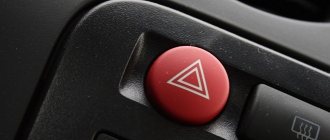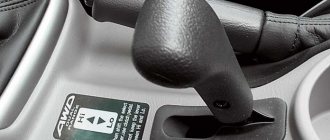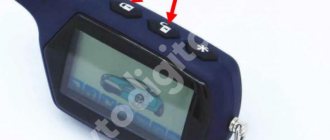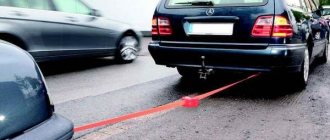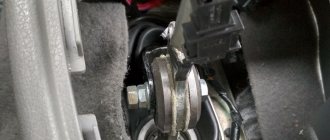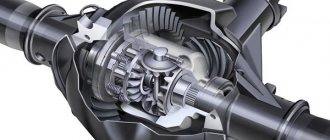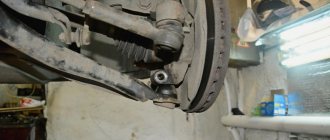Hi all! Modern cars are equipped with different gearboxes, but some components remain the same. For example, this is a neutral gear on an automatic transmission, on a manual transmission and on the same sequential gearbox.
Having not studied the principle of operation, motorists who previously drove a manual gearbox begin to ask all sorts of questions due to the habits formed at the previous checkpoint.
In particular, not everyone understands why neutral is needed on an automatic transmission, whether it is possible to coast in this case, and how to use this gear correctly so as not to harm your own vehicle.
But not everything that can be done with neutral on a manual transmission can be done on an automatic transmission. That's what this material was prepared for. Today we’ll talk about such a unit as an automatic transmission and neutral on it.
Why is neutral gear needed in an automatic transmission?
Many drivers of cars with an automatic transmission may never shift to neutral during their entire operation. Despite this, neutral gear (or another automatic transmission mode that simulates it) must be present in the gearbox. This is necessary for towing the car.
If you read the service manual for a vehicle with an automatic transmission, you will find information about how to tow your vehicle. Manufacturers recommend that when towing, engage the towed vehicle with an automatic transmission in neutral gear and drive at a speed of no more than 50 kilometers per hour. At the same time, most often, towing recommendations also indicate that a car with an automatic transmission should not be towed further than 50 kilometers, and if it is necessary to cover a distance of more than 50 kilometers to the destination, it is better to use a tow truck or tow with the car’s drive wheels raised.
Another scenario where the neutral gear of an automatic transmission can be used is when parked. It is recommended to leave the car in neutral with the handbrake in the parking lot only in cases where there are problems with the operation of the parking mode - P. It is worth noting that if the car is in neutral, you will need to depress the brake pedal to start the engine.
Recommendations for drivers
To sum up the question: is it necessary to switch the automatic transmission to neutral while the car is parked at traffic lights, intersections or in a traffic jam, we will consider all the positive and negative arguments for moving the gearbox selector to neutral.
Considering all the nuances of the operation of an automatic transmission, the best recommendation for drivers is to choose the “golden mean”. This means that moving the handle to “neutral” is possible, but in rare situations, and only to prevent overheating of the “automatic” and a short rest from pressing the brake with your foot.
Coasting in neutral is also allowed if the slope is smooth and the car comes to a complete stop before “drive” is engaged. You should not abuse this method of driving. In addition, a late oil change or the use of low-quality fluid leads to premature failure of the automatic transmission.
Source
Should I put the automatic transmission in neutral at a traffic light or in a traffic jam?
Perhaps one of the main misconceptions of drivers of cars with an automatic transmission, who previously drove a car with a manual transmission, is the need to shift the gear lever to neutral while stopping at a traffic light. When driving a car with a manual transmission, the driver moves the lever to the neutral position so that the foot can be removed from the clutch pedal. However, the automatic transmission does not have it, and there is no need to switch to neutral.
If you understand the mechanics of the process, it must be said that when mode D (drive) is turned on, the torque converter of the automatic transmission builds up pressure, due to which torque is transmitted. In this mode, active lubrication of gearbox elements occurs. If the accelerator pedal is not pressed, the torque converter is in the “green zone”, during which it is lubricated and no further processes are performed. By switching to neutral, the driver will open the input and output shafts, thereby interrupting the lubrication of the gearbox elements. When the traffic light turns green, switching back to “drive” mode will become stressful for the transmission units, as the pressure will change. Accordingly, the elements of the box will have to perform unnecessary movements, which will negatively affect them and bring the point of failure closer.
The issue of a car being stuck in a traffic jam should be considered in a similar way. There is no need to switch the automatic transmission lever from mode D to N in a traffic jam. As a last resort, if there is absolutely no movement in the traffic, you can switch the lever to position P (“parking”) or simply turn off the engine.
Tips for beginners
Having figured out when and how to use neutral gear, there are a few more useful lessons to learn.
Beginners should be given the following recommendations:
- Do not stop and leave the car in position D with the engine turned off;
- from position D the engine does not start because there is a special lock;
- to start you need to go into park or neutral;
- if the start occurs in position N, you must first depress the gas pedal, otherwise the car will start to roll;
- if it is a parking lot, there is no need to press the brakes, since the wheels are already locked;
- Having started the engine at N or P, let it run a little so that the engine and gearbox pump oil through the system.
As you can see, the machine also has its own recommendations and operating features. If you violate these rules, then you may encounter unpleasant consequences in the form of breakdowns and premature wear of the automatic transmission.
Is it possible to coast with an automatic machine?
In the desire to save fuel when driving downhill, drivers of cars with an automatic transmission may consider switching the lever to position N. This should never be done, for several reasons:
- In the “neutral” position, the gearbox units are not properly lubricated, which is necessary when the machine is moving;
- The driver's options for maneuvering are significantly reduced; if necessary, he will not be able to increase the speed of the car, for example, to get around an obstacle;
- Switching to mode D from position N while the vehicle is moving is strictly prohibited due to the sudden pressure drop. This can lead to automatic transmission failure.
You should coast in a car with an automatic transmission in D mode to avoid problems with early failure of automatic transmission parts.
( 470 votes, average: 4.56 out of 5)
How to operate an automatic transmission
How to properly break in new summer and winter tires
Related Posts
What is the N position used for?
One of the most common questions among those who have recently switched to an automatic transmission is why a neutral is needed on an automatic transmission and in what situations it is used.
Neutral on an automatic transmission is significantly different in its application from the use of neutral on a manual transmission.
Very often, drivers who have previously driven manuals all their lives, out of habit, turn on neutral at traffic lights, and then switch to Drive again. This is a common mistake that can lead to serious negative consequences.
Lada XRAY 2.5 thousand km - review from a real owner. Part 5
So I got to the most controversial part of my review/review - the AvtoVAZ automatic transmission. What to take: an AMT robot or simple mechanics - this is the most common question on forums and communities visited by Lada XRAY.
Robot AMT
I will describe my feelings and my conclusions. If you do not agree with them, welcome to the comments.
You need to understand that the AMT robotic gearbox has both its advantages from mechanics and its disadvantages, again, from mechanics.
Due to the fact that the robot depresses the clutch and changes speed, the driver cannot interfere with this process at all. The box has no eyes and does not understand what you want from it at this very moment. You can only tell how the gas works and that’s it.
If a hydraulic automatic machine’s algorithms have been more or less debugged for a long time, and the technology itself is different, many mechanical problems are simply absent from it. So the comparison can be purely speculative. But in fact, AMT is not an automatic machine, and that says it all!
Pros of AMT
- The main advantage of the robot is that engine power is not lost due to the torque converter of a conventional automatic transmission.
- The car can be towed with a cable.
- The car can be started "from the pusher".
- You can jump out of the mud “into the swing.”
Cons of AMT
- When switching, the connection between the engine and the wheels is broken and theoretically this can provoke a skid in icy conditions (this can be solved by switching to manual mode).
- Until you press the gas, the car stops (features of the robot), in contrast to the easy acceleration with an automatic transmission.
Because of this, it is more difficult to take off on an uphill climb - the car rolls back, and it is not so convenient in a traffic jam. - The gear shift speed cannot be adjusted. It takes 2 seconds and that’s it!
- It is impossible to control the coasting and because of this the car jerks in 1st and 2nd gears.
Everything seems simple, but the devil is in the details!
Rollback
Rolling the car back is a huge problem for me, because for 7 years I simply forgot about such a problem.
Although my configuration has a hill starting assistant, it only works when the brake is pressed firmly and when the slope is higher than 2%. That is, on a slight slope the car still tends to roll away. But how much is the question.
And it's unnerving. So if I feel that the car behind me is too close, then I pull away with the handbrake, as I was taught in driving school.
Due to the fact that the car is standing still without pressing the gas pedal, it is more difficult to move in a traffic jam.
In addition, with conventional mechanics, the starting speed is regulated by 2 pedals, and with a little skill, you can even hold the car in place while standing at an uphill intersection, playing with these two pedals (although this is not recommended because you will burn the clutch). And the robot works rough for my taste.
Although perhaps this is also because, out of habit, as with an automatic transmission, I try to give the gas very carefully and weakly. But it turns out: I gave the gas - it doesn’t go, I gave it more - it stops, I gave it more - it jumped forward, and you hit the brake. In general, I try to feel the car, it turns out better every time.
There is no coasting on the robot
Due to the inability to independently control the roll-up in neutral, the robot often jerks, which I really don’t like. I rarely braked with the engine, I coasted more. Here's an example: I'm driving on a secondary road in the city and accelerate from the intersection to the 1-2-3 intersection and turn off the speed and coast.
And then 1-2-3 and the third remains, and when you release the gas the car jerks - the coasting does not turn on. It seems that all the instructions advise to always drive with the speed on, as it also reduces gas mileage.
But if you don’t turn off the speed at 1-2 speeds on any manual transmission, if you release the gas pedal, then there will be jerks and a kind of engine braking.
When moving down a hill, the robot often suddenly decides that it needs to brake with the engine and begins to feverishly apply a lower gear. And in 5 seconds it suddenly turns out that from speed 5 you already have speed 3 or even speed 2, the car slows down too much. It’s difficult to deal with this; you need to either press on the gas (during descent) or switch to manual mode.
Dips when switching
Due to the fact that the robot presses the clutch and also turns on the speed, AvtoVAZ adjusted the switching time to 2 seconds for comfortable driving. And this cannot be changed.
When you drive an automatic transmission, the gear changes almost instantly, you only feel a slight jerk if you press the gas hard. The robot may not have a jerk, but switching takes 2-3 seconds.
The driver feels this time is wasted: he presses the gas, but the car does not accelerate. The passenger doesn't notice anything!
There is a decent gap between speed 1 and 2. There is also a dip between speeds 2 and 3, but it is much less noticeable. At first, the failure really annoyed me. Especially when you turn left or right from a secondary road onto the main road. The robot starts switching right in the middle of the intersection, which is potentially dangerous.
However, the robot has two kickdown modes: when you press halfway and when you press fully. Alas, you can only feel the revolutions with your ear; on an electronic pedal it is almost impossible to determine the difference.
So, with an active kickdown, the robot will not switch until you release the gas . But if you overextend it or overdrive it, it seems to freeze at 4-5 thousand and until the revolutions drop to 1200 - 1500, it will not switch to speed 2. It can be treated by moving the gearbox to neutral and back. Or to manual mode and back.
Again, once you get used to it, this failure doesn’t bother you at all!
Another point is that you can change speeds by playing with the gas pedal. Or, more precisely, tell the robot that it can switch to a higher or lower gear. Information about this is found in fragments in the video, but for some reason it is not systematized! And it’s not in the user manual at all.
In general, at engine speeds somewhere around 2500, when the gas is released, an upshift occurs and the speeds level off. You just need to remember the sound of the engine and feel the moment of switching and there will be no problems.
And if you sharply press about halfway, the box will drop one speed down. If you press it completely, it will reset 2 speeds down. It is important to feel the difference between the first and second kickdown.
Having felt these simple rules, you can move quite confidently in traffic both in the city and on the highway.
A robot for a quiet ride
There is a myth that AvtoVAZ cultivates that the robot is configured for a comfortable ride. This is not entirely true.
If you drive like a vegetable, then the ride is not very comfortable - the robot's thoughtfulness is annoying.
But if you drive actively: you press the gas and turn the engine, then you can drive even with greater comfort.
Paradox? No, these are the box settings.
It turns out that when you drive at a speed of, say, 40 km/h, the robot switches to gear 3, which is logical. And here in the city there is an obstacle ahead, but far away. Therefore, you release the gas and the car smoothly brakes with the engine (everything is also logical).
But the speed remains 3! And then a window appears, you need to speed up (but not much): you step on the gas and POP! First, the engine must leave the 600 rpm mode to at least 1500-2000 thousand, and this is 1-2 seconds, then the pickup begins and the car begins to accelerate.
Another 2-3 seconds. And the window closes.
This moment is quite annoying. If you drive actively, then such braking does not occur in the city and you can quite feel the flow well. But there's a bit of a jam.
How the robot behaves on the highway
But on the highway, surprisingly, the robot performs well - all the time 2000-2500 thousand revolutions, the engine pulls from low, so it’s quite possible to drive actively.
When overtaking, there is an easy kickdown to speed 4 and there is enough time to overtake even a truck at a speed of about 100 km/h. If you need to overtake more or more actively, you can switch to manual mode.
Driver adaptation
I don't know, somehow I didn't notice it. At all. Either I drive too differently, but the automatic machine often doesn’t understand me.
Manual AMT mode
If you wish, you can pull the handle yourself - just pull the joystick to the left in position D.
Speeds are switched by nodding forward - reset, back - add. Quite logical and comfortable.
If you slow down, the robot will try to maintain the speed, but if there is a heavy load on the engine and below the hardwired speed values, then it automatically resets everything down to speed 1. But it doesn’t shift the speed up (maybe it’s possible, but I didn’t turn the engine before the cutoff—it was still during the run-in).
So you can comfortably drive in manual mode in the city, you don’t need to pull the knob at every speed: you go to 4, brake at a traffic light, and the speed resets itself to 1. So all that remains is to touch the knob again to increase. Or when overtaking, reduce the speed down by 1.
When you pull the handle, the speeds subjectively switch a little faster and you drive comfortably - you know that there will be a failure now and you automatically release the gas pedal.
In general, it's convenient. You just need to practice a little.
There is also an up-down shift prompt, but it is not adequate in 90% of cases: you are driving 40 km/h, let off the gas a little, and it advises you to turn on gear 5. Well, and the like. Annoys me, may be useful to someone. It's a pity that you can't turn it off normally.
Will the robot squeeze the clutch?
To be honest, I’ve seen this opinion in videos. But I didn't understand where it came from. There was and still is no smell of a burning clutch (it’s already passed 2,700 thousand).
But in cold damp weather, about 0 in cold weather gives a vibration similar to the clutch disc slipping along the basket. Especially uphill.
This may be due to the fact that the clutch has been worn in and the gap has increased slightly. So I’ll ask for adjustment to TO-0, maybe they’ll also change the firmware.
My opinion about the robot
I described in great detail the behavior of the robot in different situations and what to pay attention to. But I don’t have a clear answer to the question: which is better: a robot or a mechanic!
Very strange sensations: on the one hand, this gearbox has better consumer qualities than a manual transmission, is more convenient to use, and more progressive. On the other hand, compared to an automatic transmission, it loses outright! And let me remind you again, I drove an automatic for 7 years and got used to it.
And I don’t understand how you can do a thing that you need to learn to manage separately. No, there are generally accepted skills in driving a car, and why should I also learn to control a robot box, and even without information or tips. And in 3 months I can’t get used to the car! I would drive a manual for 2-3 weeks and drive calmly, I have 13 years of experience in mechanics.
So only you can answer this question: order a test drive at a car dealership and drive the car in different modes. I really don’t recommend buying without a test drive!
The fact that it sits on this box with mechanics will be easier. But all the same, no matter what kind of automatic transmission they take (another brand, not XRAY) or AMT, they will still spit a lot and often at the automatic and think that “a manual would be OH-H-H-H.” Until they get used to it. And they won’t reconcile themselves. Believe me, for the first 2-3 years you will still be looking for the gear shift lever :).
But I definitely don’t recommend this gearbox to people with automatic transmission experience! Having driven the best, you will be very unpleasantly surprised and upset at the worst. You will have to come to terms with a lot of unpleasant nuances of this box.
Personally, I would rather pay this unfortunate 25 thousand extra for a full-fledged automatic transmission or save on the configuration (I still took it on credit).
Previous parts of the review
Source: https://garage-yourself.ru/lada-xray-2500-tyisyach-km-otzyiv-realnogo-vladeltsa-chast-5/
Change of oil
If a person has driven a manual transmission almost all his life, then he is accustomed to the fact that the oil in the box needs to be changed very rarely, because in mechanics it is almost eternal. But in a classic automatic machine, things are a little different - it needs to be changed every 60 thousand kilometers, and if more often, then even better. Moreover, this should always be done, even if the manufacturer assures that the oil is intended for the entire service life of the car. This phrase is a common marketing ploy, because the manufacturer only means a warranty period, which is no more than 150 thousand kilometers. If you do not change the oil, then irreversible processes will begin in the box, which will lead to serious problems: replacing clutches or major repairs. As you know, all this costs a lot of money.
The neutral bias voltage is determined by the following formula
in the formula above:
- Ea, Ev, Ec – EMF of the power source
- Ua, Uv, Us - the conductivity of the consumer phases, recall that conductivity is the reciprocal of the total resistance, that is, U = 1/Z
- 00' – these points correspond to the zero of the load and the zero of the generator (transformer) supplying this load
By neutral displacement we mean that voltage arises between the neutral wire of the source and the load, and current flows through the neutral wire. But, this is the case if the neutral wires are connected. If the neutral wire of the source and load are not connected, then a displacement of the neutral can cause a violation of the magnetic balance in the transformer.
Case 1 – homogeneous load uniform across three phases
The ideal case (symmetrical load), in which the neutral does not shift, the sum of the voltages at any time is zero, the linear voltages of the three phases are ~380V, the phase voltages are ~220V. Load homogeneity means that it is either active, inductive, or capacitive in nature in all three phases, as electronics would say - the “or” element. In our example, the statement that Xa=Xb=Xc will be true.
Case 2 – the load is homogeneous and uneven across three phases
Under this set of circumstances, the neutral is displaced, which corresponds to the segment 00' in the figure on the top left, which creates a current in the neutral wire. Displacements to one side or another of point 0' from point 0 will depend on the nature of the load. In this example, the load is homogeneous but uneven, varying in magnitude but not in type.
Case 3 – load on three phases is heterogeneous
In the case of heterogeneous uneven loads, the neutral point of the load (0') went beyond the triangle. The values of phase voltages at the load exceed this value at the power source several times. However, it should not be forgotten that this offset occurs only at the load and not at the power source.
Load heterogeneity will affect the power source (transformer or generator) only if this load is large relative to the source. In this case, a violation of the magnetic stability of the transformer may occur.
Keep in mind that the higher the load, the greater the impact it can have on the system, just as large motors are more likely to sag busbar voltage during power outages in power plants.
Latest articles
Most popular
Scandinavian light - an inexpensive alternative to DRLs: how to connect it yourself
When you see a green light turn on in front of you, or realize that the traffic in a traffic jam is about to start moving, by switching to neutral first and then switching to drive again, you will create conditions of serious stress for your transmission. This is due to the fact that the pressure inside the system will change dramatically. Therefore, the automatic transmission components will have to perform additional manipulations and movements, which will ultimately affect the life of the entire gearbox.
The same should be considered when you are in a traffic jam. In traffic jams there is no need to switch from drive to neutral.

